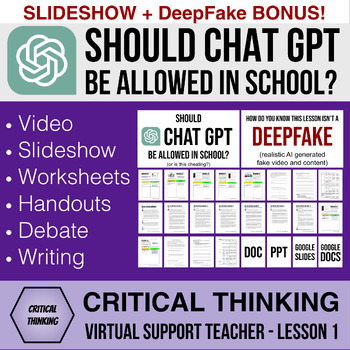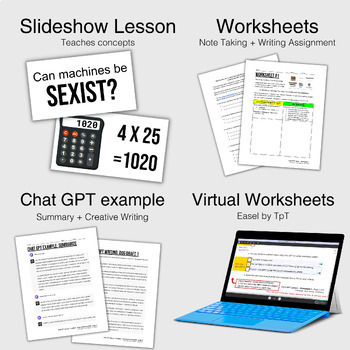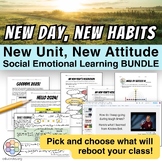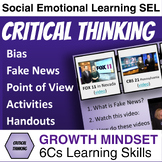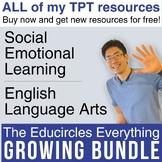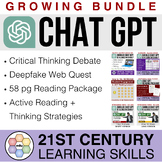ChatGPT Critical Thinking Debate Slideshow: Should ChatGPT be allowed in school?
- PDF
- Easel Activity
What educators are saying
Also included in
- Reading Comprehension and Reading Intervention GROWING Bundle for Middle School and struggling High School students.This is a growing collection of ALL of my reading comprehension resources. What's the difference between the 10x Reading Bundle and the Reading Mega Bundle?This resource (10x Reading GPrice $49.99Original Price $207.49Save $157.50
- Does your class need an attitude adjustment? Are you starting a new unit or term and you want to start fresh? This bundle includes 5 different activities to reset your classroom expectations before starting your next unit.Some of the resources talk about New Years Resolutions, but the reality is setPrice $4.99Original Price $62.00Save $57.01
- A Social Emotional Learning curriculum that isn't babyish or cheesy! Here are 90+ fun lessons to build Social Emotional Learning skills that help students succeed at school and in life! Reset classroom expectations by explicitly teaching students: character, citizenship, collaboration, communicationPrice $54.99Original Price $242.00Save $187.01
- Here are 24 Fun High-Interest Critical Thinking lessons to help your students put on their critical thinking hats!Strategies to help your students make informed decisions about the news, search engine results, and Chat GPT / Artificial InformationIncludes detailed lesson plan with discussion points,Price $40.48Original Price $112.00Save $71.52
- This growing bundle includes every single resource in my TPT store. Buy now and get all future resources for free!Oh no, you missed out! This resource was on sale for $100 to celebrate 100,000 downloads across my TPT store. Make sure to join the Educircles Club Newsletter to get free stuff and speciPrice $144.00Original Price $482.49Save $338.49
- High-interest critical thinking lessons: Should ChatGPT be allowed in schools? Or is this cheating?The slideshow / video lesson provides information from different points of view to help students make a more informed decision.Digital Literacy (Ontario Language 2023 Curriculum Strand A2 Digital MediaPrice $14.50Original Price $31.00Save $16.50
Description
Should Chat GPT Artificial Intelligence tools be allowed in schools? Or is this cheating?
- FULL ChatGPT Slideshow Lesson + Editable Worksheets
- Chat GPT / Artificial Intelligence Critical Thinking Debate
- Writing Reflection Assignment
- Includes bonus Deepfake Critical Thinking Lesson + worksheets!
FREE: The entire CHAT GPT critical thinking video lesson is on YouTube
- The shorter version (1h 19m) tells you when to pause the video to lead a classroom discussion.
- The longer version (3h 19m) explains to students how to fill out the worksheets. It also includes a visual timer during work periods.
PAID UPGRADE:
- If you only want PDF versions of the Chat GPT worksheets seen in the video (Worksheets #1-5), click here.
- If you want the PDF worksheets, AND the full slideshow lesson, editable versions of the file, handout with the ChatGPT generated response seen in the video, bonus slideshow lesson about Deepfakes, and bonus worksheet #6 about Deepfakes, then you want this resource.
"I used this as part of my emergency sub plans. It's a great resource and there are many activities to keep the kids busy if I'm out."
⭐⭐⭐⭐⭐ Renee M. 7th Grade Teacher
May 9, 2023: Oh no, you missed out!
- As a special thank you to those of you who FOLLOW my TPT store or subscribe to the Educircles Club newsletter, this ChatGPT slideshow lesson was FREE until Monday, May 8, 2023 at 11:59 PM (ET).
- Tired of missing out? Check out the Everything Bundle. Buy now, and get all of my new resources for free!
CONTENT WARNING: Sensitive Topics in the Deepfake Bonus
Please note that the bonus question (worksheet #6) in this critical thinking lesson discusses Deepfakes. The main ChatGPT lesson, which includes YouTube videos and worksheets #1 to #5, is safe and does not mention Deepfakes at all. However, the bonus question may lead to discussions or references to explicit material. For more information, please see the full warning at the bottom of this product description or on the last page of the START HERE PDF.
❤️ Like this resource? Check out the BookFace 10x Reading Program which includes this resource and more: 1047 slides, 205 pages of handouts and worksheets, 187 pages of lesson plans, and 149 pages of answers! SAVE TIME and MONEY!
This is the full slideshow lesson version of The Chat GPT Virtual Substitute Teacher video lesson resource found here.
You get:
- the slideshow seen in the video (Google Slides, Microsoft Powerpoint)
- editable versions of the Chat GPT worksheets (Google Docs, Microsoft Word)
- an editable copy of a handout with the writing produced by the ChatGPT Artificial Intelligence seen in the video.
- virtual worksheets and handouts that students can fill out online
(Easel by TPT)
- bonus lesson about Deepfakes.
Want to see exactly what you get before you buy this Chat GPT slideshow product?
- Look at the PREVIEW video.
- Look at the PREVIEW PDF.
(It is a watermarked version of the entire PDF resource and worksheets.)
- Look at the PREVIEW SLIDESHOW.
(It is a watermarked version of the entire slideshow lesson + bonus lesson.)
- Watch the video lesson on YouTube. There are two versions: 1) a SHORTER video and 2) a FULL VIDEO LESSON with handout instructions.
- Find out how to get this resource for LESS THAN $1.00
Machine Learning AI updates to Google will completely change the way students learn (and maybe cheat?)
Chat GPT and Artificial Intelligence tools are really about developing 21st-century learning skills and social-emotional learning skills to survive and thrive in a changing world.
First covid, then ChatGPT and Machine Learning AI...
Who knows what's next?
Critical Thinking Topics
- What is Chat GPT?
- How well can Chat GPT summarize and find the main idea from complex texts?
- Can Chat GPT Artificial Intelligence really produce creative writing with personal examples? (How creative can a robot be?)
- The Google Search Algorithm has learned to be sexist (and what you can do about it.)
- Should I panic about Chat GPT and Machine Learning AI?
- Should I trust my robot friend?
Multiple Assessment opportunities throughout the lesson
- Students fill out worksheets to document their learning at multiple points in the lesson: (beginning, middle, and end)
- Students provide evidence from the text (Chat GPT virtual substitute teacher video lesson or the Chat GPT slideshow lesson)
- Students explain their own thinking (i.e., asking questions, making connections, inferring, evaluating, repairing comprehension, or finding the main idea.)
- Students collaborate and participate in small group and whole class conversations to develop a deeper understanding of the Chat GPT critical thinking debate.
- These conversations can provide multiple opportunities to listen to students to see what they understand about Chat GPT and why this matters. (Anecdotal observation / assessment.)
- Students brainstorm criteria to decide if Chat GPT should be allowed in schools or is this cheating. (Worksheet 5) What's the point of school? What does cheating mean?
- The Chat GPT slideshow lesson and the long version of the Chat GPT Virtual Support Teacher video walks students through a FOUR CORNERS debate.
- At the end, students fill out a written response: Should Chat GPT be allowed in schools? An optional rubric is included. Students are asked to make a point, provide evidence from the text, and explain how the evidence from the text proves their point using criteria.
WHAT’S IN THE PDF DOWNLOAD:
- Instructions / title page
- Links to files (File Table of Contents)
- Worksheet #1 - If you do not change… (initial thoughts)
- Worksheet #2 - Should Machine Learning AI be allowed… (initial thoughts)
- Artificial Intelligence generated example: Summarize and Creative Writing
- Worksheet #3 - Should Machine Learning AI be allowed… (after writing example section)
- Worksheet #4 - If you do not change… (after writing example section)
- Worksheet #5 - Should Machine Learning AI be allowed… (after bias / action section) - Criteria Brainstorming - Writing Response - Rubric
- Worksheet #6 - Bonus Lesson: Is this a Deepfake? - Criteria Brainstorming - Writing Response - Rubric
- About Educircles, License, Copyright, Sources, Changelog
WHAT’S NOT INCLUDED IN THIS RESOURCE:
This resource does NOT include: lesson plan or answer key
Separate video files. (The videos are posted on YouTube - check out the links at the top of this product description!)
Questions?
Is there a lesson plan or lesson timing overview?
No, not yet. This is an early-bird product that you are getting for a discount.
When the lesson plan is published, the price of this product will go up.
For now, please watch the YouTube videos to get a sense of timing.
Is there an answer key?
No, not yet. This is an early-bird product that you are getting for a discount.
When an answer key is published, the price of this product will go up.
If you and your class get stuck, please email me using your teacher account. (Sometimes, students try to email me for the answers.)
CONTENT WARNING: Sensitive Topics in the Deepfake Bonus
Please note that the bonus question (worksheet #6) in this critical thinking lesson discusses Deepfakes. The main ChatGPT lesson, which includes YouTube videos and worksheets #1 to #5, is safe and does not mention Deepfakes at all. However, the bonus question may lead to discussions or references to explicit material.
The bonus question (worksheet #6) has students explore the question: how do we know this video isn’t a Deepfake? How do we know this lesson wasn’t made by ChatGPT or Artificial Intelligence? (A Deepfake is a realistic AI-generated fake video or content.)
Teachers should exercise caution when leading a class conversation around the term "Deepfake" on the open internet, as it may expose them to inappropriate content for school.
For this reason, a specific, safe website is provided in the handouts and lesson to concentrate the learning conversation. The recommended resource is SpotDeepFakes.org , an educational tool developed by The Center for an Informed Public at the University of Washington, in collaboration with Microsoft, USA Today, and Sensity. This website will help students explore the topic without encountering inappropriate content.
For teachers who want to learn more about the origin of Deepfakes and the Reddit user "deepfakes," it is suggested to start with the Wikipedia article on the subject, specifically the section on amateur development: https://en.wikipedia.org/wiki/Deepfake#Amateur_development
Before teaching the bonus lesson, teachers should consult with their principal or school administration for advice on how to ensure that the critical thinking lesson aligns with school guidelines and policies on sensitive topics.
If you have any questions about this ChatGPT critical thinking slideshow lesson, please ask me in the TPT Question & Answer section or email me directly at Mike@educircles.org

